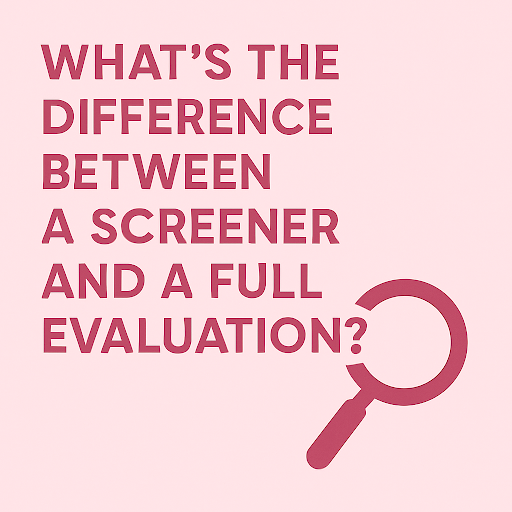What's the Difference Between a Screener and a Full Evaluation
Understand when to use screening tools versus comprehensive evaluations for optimal assessment

If you're an SLP in a school or private setting, you've likely heard this question from teachers, caregivers — and sometimes even colleagues:
"Can you just screen them instead of doing a whole evaluation?"
While it sounds simple, the difference between a screener and a full evaluation is significant — in scope, purpose, and legal weight. Understanding the distinction (and being able to explain it clearly) is critical to protecting your time, your license, and your students' or clients' rights.
Let's break it down.
What Is a Screener?
A screener is a brief, informal tool used to determine whether a child is at risk for a speech-language disorder and may need further evaluation.
Think of it like a checkpoint — it gives you a quick snapshot, not a diagnosis.
SLPs use screeners to:
- Identify potential speech, language, or voice concerns
- Determine if a referral for a full evaluation is warranted
- Guide decisions in RTI, MTSS, or early intervention contexts
✅ Screeners do not require parental consent in most settings (especially in schools), but policies can vary.
✅ They're not used to qualify a child for services.
What Is a Full Evaluation?
A full evaluation is a comprehensive, formal assessment that determines whether a child meets criteria for a speech-language disorder — and qualifies for services.
It includes:
- Standardized testing
- Informal observations
- Interviews with caregivers/teachers
- Language samples or dynamic assessment
- Functional impact analysis
- Written interpretation and recommendations
Full evaluations:
- Require informed parental consent
- Must follow timelines (in schools, often 60 days)
- Are used to determine eligibility under IDEA or insurance
- Result in a legal document (e.g., IEP or evaluation report)
Screener vs. Evaluation: Quick Comparison
| Feature | Screener | Full Evaluation |
|---|---|---|
| Time | 5–15 minutes | 1–3 hours (plus write-up) |
| Consent needed? | Often no | Yes |
| Used to qualify for therapy? | No | Yes |
| Tools used | Brief checklists, quick tasks | Full standardized tests, interviews |
| Outcome | "At risk" vs. "not at risk" | Diagnosis, eligibility, goals |
When to Use a Screener
- A teacher or parent says "I'm not sure, but something seems off."
- You need to make decisions in a tiered intervention setting.
- You're monitoring articulation development in a borderline case.
- A child is multilingual, and you want to screen in both languages before pursuing further testing.
Pro tip: Keep data from your screeners — they can help justify full evals later.
When to Skip the Screener and Go Straight to Eval
- Concerns are significant and well-documented
- There's regression or sudden change in communication
- You're in a re-evaluation cycle under IDEA
- A parent has already requested a full evaluation
- You're documenting progress for insurance authorization
Sometimes, screeners create an unnecessary delay. Trust your clinical judgment — and your data.
Explaining the Difference to Teachers or Caregivers
Use this simple analogy:
"A screener is like a quick vision check — it tells us if we need a full eye exam. The evaluation is the full exam where we test everything and write up a report."
You can also say:
"Screeners help us catch kids early. Evaluations help us qualify them for services."
How SLP Score Helps with Both
Whether you're screening or evaluating, SLP Score makes your workflow faster and more defensible.
With SLP Score, you can:
- Auto-score over 60 standardized tests
- Generate narrative write-ups in clear, parent-friendly language
- Store and document informal screener notes alongside formal assessments
- Export clean reports to Google Docs or Word — with one click
No more toggling between PDFs, hand-scoring, and overthinking how to phrase your findings.
Save Time. Show Your Reasoning.
Streamline your screeners and evaluations with SLP Score.
Start Here →